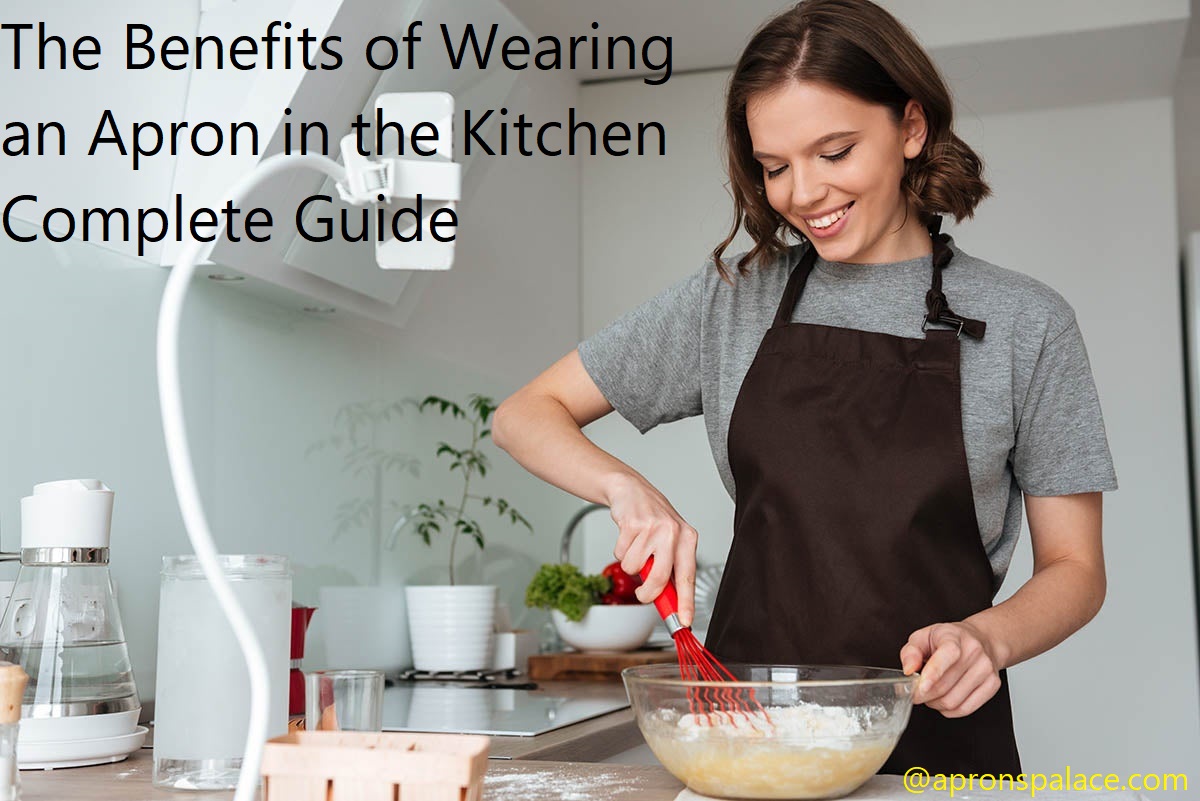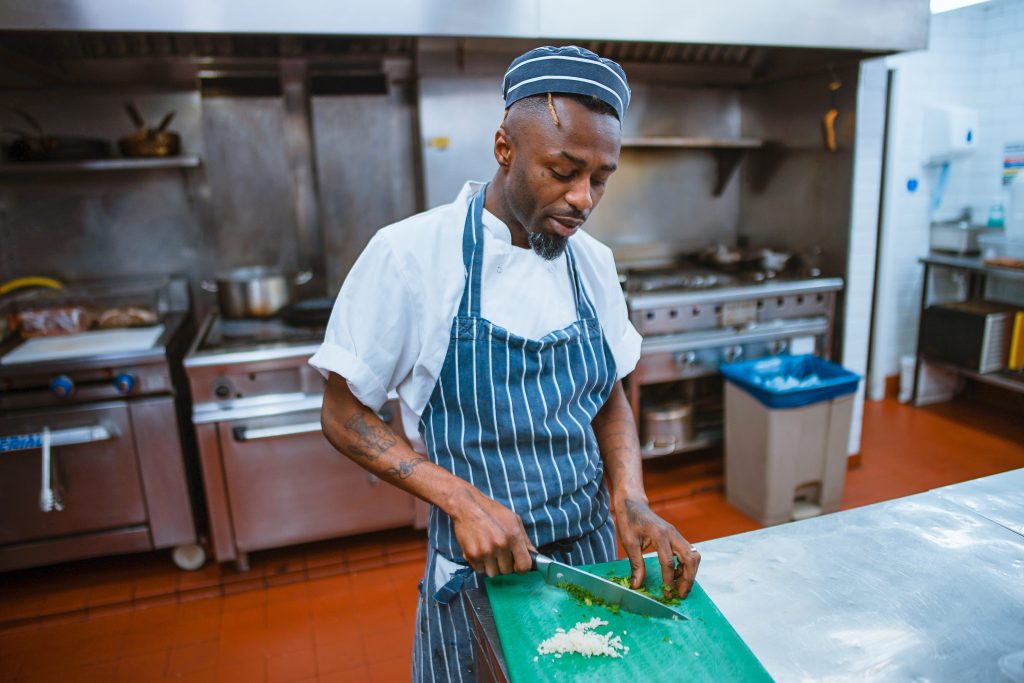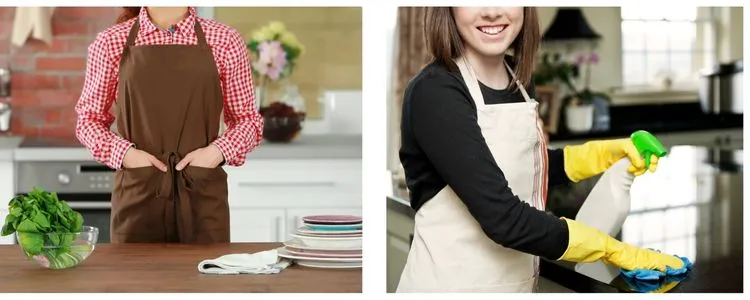Are you tired of getting your clothes dirty while cooking? Wearing an apron can protect you from spills and splashes. In this complete guide, you’ll learn everything there is to know about the benefits of wearing an apron in the kitchen. Don’t miss out on protecting your clothes, and discover how an apron can help!
Cooking can be an exciting and rewarding experience. Whether it’s a quick family meal or an elaborate Sunday brunch, the challenge of creating delicious meals keeps many people in the kitchen. But every great cook knows that professional-level cooking requires more than just mastery of a recipe; it involves proper attire.
An apron can be an essential part of the chef’s wardrobe, offering protection from physical hazards and providing a stylish presentation in front of guests. This guide will provide information about the benefits of wearing an apron in the kitchen and give tips on how to choose the right one for you.
Definition of apron
The word apron dates back to the 1300’s when it meant ‘a piece of clothing or other material used as a protection from dirt, heat, or injury.’ Today, aprons are commonly worn in the kitchen as well as by service professionals for protection from spills and other messes.
There are a variety of kinds of aprons available on the market, ranging from half-length to full-length styles of varying thicknesses and materials such as cotton, linen and canvas. Aprons come in all sizes, colors and patterns to suit any taste and style. There is also the option of having an apron customized with company logos or special designs.
Whether you’re cooking at home or a professional chef in a commercial setting, wearing an apron provides more than just protection — it can be stylishly utilitarian. Here are some benefits to wearing an apron while working in the kitchen:
- Protection against spills: An apron creates barrier between you and any messes in your workspace (particularly for chefs who work with hot liquid substances like soup or sauces).
- Easier clean up: An apron can help shield your outfit from splatters and other residue that can be difficult to remove from fabric. And if your clothes do need cleaning up afterward, you already have an extra layer on hand for quick cleanup!
- Reduced risk of getting burned: In addition to protecting yourself against spilt liquids, wearing an apron helps insulate you from direct contact with heat sources like open ovens or grills.
- Added convenience: Aprons often have pockets where you can keep utensils while they’re not being used — reducing hassle and keeping them close by whenever needed.

Brief history of aprons
Aprons have been around for centuries and date back to the Middle Ages. In those days, aprons were worn by servants or household help in many cultures as a sign of their subservient status. The style of each apron was related to their duties and could even signify their trade, with butchers’ aprons having thicker material to protect their clothes from blood and grease splatters. Aprons would also be necessary when doing laundry, as the strong soap would not be kind on fabric.
In addition to being utilitarian, though, aprons also served as a symbol of motherhood and protection. Many women in the pre-20th century generations viewed themselves not only as housekeepers but also as protectors of home values. As such, they often hung on to their cherished garments even after modern times brought an end to more elaborate varieties of aprons.
In recent years, aprons have finally made it into fashion thanks largely to vintage clothing stores who celebrate good design from different decades. From traditional greyscale workwear designs to bold prints with ties reminiscent of pop art, today’s kitchen worker can choose from a wide range of styles – some more practical than others!
Benefits of wearing an apron in the kitchen
Just like in the old days when women wore aprons over their dresses to protect their clothing from spills and splatters, wearing an apron in the kitchen has some great benefits for cooks of all ages. Not only do they help keep your clothing clean, but they can also help reduce risks of injury from handling hot pans and other kitchen activities. Here are some of the many benefits of wearing an apron in the kitchen:
– Protection from spills and splashes: Aprons provide some protection against accidental spills, splashes, and even minor burns. Since most modern aprons are made of materials like cotton or polyester blends to make them durable and breathable, these items can provide more protection than regular clothing in certain situations.
– Protection from hot pans and hand tools: Aprons often incorporate pockets or straps to hold on to kitchen tools such as spatulas or tongs. This can help prevent hot tools from slipping off your hands while transferring them from the oven or stove top to the counter tops. In addition, it allows you to have quick access whenever you need it in the middle of cooking!
– Freedom of movement: While aprons don’t restrict movement in any way, they can protect skin and clothes at any angle; whether you’re cooking on the stove top or stirring something on a low surface.
– Personal style statement: Wearing an apron is a great way to express yourself while cooking! From bright colors to bold patterns, there are endless possibilities when it comes to aprons – so show off your own personal style!
Personal benefits
Wearing an apron in the kitchen offers many advantages. The thought of protecting clothes is often the first one that comes to mind, but there are several other personal benefits to wearing an apron.
One major benefit of wearing an apron is that it helps keep clothing and skin clean. By providing an extra layer of protection between one’s clothes and food splatters or spills, aprons can eliminate staining or spots from liquids like grease, oil, and sauces. Because aprons tie around the waistline, they make it easier to move around the kitchen without having to constantly pull down garments that may have ridden up due to movement. They also make cooking with messy ingredients more comfortable by preventing anything from getting on the skin that might cause irritation or itching.
Some aprons also offer pockets for people working in the kitchen to store their tools within easy reach without having to constantly go back and forth between countertops and cabinets. By keeping tools close at hand, they allow people to work more efficiently while eliminating any potential germs from resulting from repeated distractions. Most newer aprons have adjustable straps that come in handy when busy hands can’t stop what they’re doing in order to adjust their fit throughout the day—making them ideal for people who wear multiple hats while they cook!
Protects clothing from stains and spills
An apron is an essential kitchen accessory for anyone spending time preparing food. An apron helps protect clothing from food stains, splatters and spills and can save you from having to spend money on dry-cleaning bills, or having to purchase a new outfit entirely.
There are many different styles of aprons available that can help protect clothing and improve comfort. Some offer full chest coverage while others end at the waistline; some have neck straps for easy removal and others have adjustable ties around the waist for better fit; some prefer frill aprons for their more stylish look, while others have multiple pockets to accommodate everything a cook needs at their fingertips.
Ultimately, no matter what style you choose, an apron’s primary purpose is to keep clothing clean while working in the kitchen or behind the grill.
Types of aprons
In the kitchen, there are different types of aprons available for every culinary task you might encounter. It’s important to choose an apron that meets your specific needs. Examples of aprons include:
- Waist-length aprons – usually tied around the waist, this type of apron is lightweight and does not cover the chest area. It’s ideal for home cooks and short stints in the kitchen.
- Full-length aprons – these cover both the chest and hips and are commonly worn by servers in restaurants, but they also provide greater coverage in home kitchens as well. They normally have long ties behind them which can be tied into a bow at the back or wrappped around to the front and tied off there on either side of your waist.
- Bib apron – these provide good coverage in front but are less formal than full-length styles so they tend to be more comfortable for tasks like baking or other messy activities–the bib saves you from dirtying your whole outfit!They typically feature deep pockets to store spices, utensils, recipe cards or poultry shears – whatever you may need for dinner prep!
- Grill/Industrial Apron – grill and industrial aprons are designed to be heavy duty and can come with additional features like tool loops and double stitching for superior strength. These heavier materials do offer better protection against heat but can sometimes be uncomfortable when working with hot pans on stoves or grills all day long due to their weightiness
- Kitchen Apron – The kitchen apron comes in various lengths from short half-aprons that just about covers waist area to full length ones that covers your chest as well as most of lower body areas, sitting snugly under arms.. These kind typically provides pockets where cooking tools may conveniently kept while working away at meal preparation such as butter knives, spoons, flashlights etc.
Bib aprons
Bib aprons are lightweight, usually knee-length garments that are worn tied around the neck and waist. They feature a split bib design with fabric extensions at the neck, which provides extra protection for the torso.
Bib aprons can be worn in the kitchen or any other work environment where some type of protective clothing is necessary. Some popular styles include half-bib and full-bib aprons with pockets for holding utensils, recipes, ingredients and other necessities.
These aprons allow greater freedom of movement and flexibility while working while also adding a professional look to any kitchen staff’s attire.
Waist aprons
Waist aprons were designed to provide coverage and protection while wearing casual clothing or while performing a certain task. These types of aprons are the perfect solution for keeping clothes clean and secure when cooking or serving food. The waist apron features an adjustable neck strap, allowing maximum comfort during wear, and length from waist to mid-thigh depending on size selection. While these have been traditionally used in restaurants and the hospitality industry, it can be used for any day-to-day activities at home.
Beside covering the torso area, one of the advantages of waist aprons is that they can be easily stored when not in use. This allows you to get on with your day quickly without having to change into a different outfit. Furthermore, due to their construction with multiple pockets or pouches, they provide additional space or compartments to store items such as utensils while your hands are preoccupied with food preparation tasks. Waist aprons are also great for those who are simply tired of having a messy countertop!
How to wear and care for aprons
Having the right apron for the task can enhance your kitchen experience and save you from unnecessary messes. Many aprons have features designed to accommodate home chefs of any size, such as adjustable straps and triple stitched hems for extra durability.
Some tips for successful apron use include:
- Be sure your apron fits comfortably and is adjusted properly. If it’s too big or too small, it won’t serve its purpose effectively.
- Consider using an apron that has pockets or compartments to store items while working in the kitchen. Not only will they provide convenience, they’ll also allow you to stay organized throughout your work day.
- When selecting aprons, opt for those made of materials that are durable and easy to clean, such as cotton twill or canvas cloth. These fabrics can easily be machine washed or hand laundered with mild detergent and no bleach so they stay looking their best longer.
- Also consider purchasing an apron with straps that tie off firmly at the waist or waistband so it won’t get in the way while working. Ideally, the straps should be adjustable so you can customize them to fit perfectly while still allowing freedom of movement in the kitchen.
Wearing instructions
When wearing an apron, it is important to remember to tie it properly, not just wrap it around yourself. Aprons are best tied by crossing the straps over your back and tying them at the waist, for a secure and comfortable fit. The apron should fit snug against your body but should not be tight.
Additionally, consider how often you will be using your apron when selecting material and colors; lighter colors may be preferable if you are in a kitchen that is prone to spills or splatter.
Washing instructions
Cleaning an apron is essential to maintaining not only its appearance but also its ability to protect you from spills, splashes and germs. Most aprons are made of cotton, linen or polyester fabrics, which can be easily machine washed or hand washed in a sink using mild detergent. If washing by hand, use warm water and avoid wringing the fabric since this may damage the fibers.
To ensure that blues, whites and other bright colors stay bright, add half a cup of baking soda to the water before washing. It’s also important to separate colored aprons from whites so that runny dyes don’t cause fading or discoloration. When finished rinsing off all soap suds, use a clean towel or lay flat on a drying rack to air dry. Aprons can also be tumble-dried on low heat although this will tend to make fabrics more stiff and can cause them to shrink over time.
Storage instructions
Before and after use, aprons should be stored properly in order to maintain their condition. To ensure your apron is ready for its next culinary outing, follow these steps:
-Allow your apron to dry completely before storing it away.
-Avoid hanging aprons in humid areas, as this can cause discoloration and the growth of mildew.
-If you are using an apron made from natural fabrics like linen or cotton, store it away from extreme temperatures to prevent fading and tears.
-Hang your apron on hangers or pegs rather than folding it as this can lead to wrinkles over time.
-Storing multiple aprons together? Make sure they are placed far apart on the pegs or hangers so that they aren’t bumping up against one another throughout the day.

Conclusion
Wearing an apron in the kitchen is a great way to protect your clothes but also to help keep you comfortable and organized while cooking. Whether you’re looking to make a statement, preserve your clothes, or simply stay on-task while making breakfast, lunch, or dinner — an apron could be just what you need.
From waxed canvas to lightweight cotton and stained glass aprons with pockets and straps — there’s no shortage of options. The best aprons provide protection and look good. In addition to the protection they offer, the right kitchen apron can speak volumes about your style as a chef or baker. They also make for great gifts for those aspiring chefs in your life!
No matter which one you choose, it’s important that you purchase one that fits properly as too much fabric can get in the way or bunch up as you move around–ultimately leading to more mess and frustration than necessary. Choose carefully, stay organized and safe, and have fun wearing your favorite kitchen accessory!
FAQ’s
Why do food handlers wear apron?
Food handlers wear aprons to protect their clothing from getting stained or contaminated with food and to maintain hygiene in the kitchen.
What does apron mean in kitchen?
In the kitchen, an apron is a protective garment worn by food handlers to cover their front body and prevent food stains or contamination.
Is an apron for food safety?
Yes, an apron is a crucial component of food safety in the kitchen, as it prevents the spread of harmful bacteria and ensures hygiene.
Why are safety aprons important?
Safety aprons are essential to protect the body from heat, chemicals, and other hazardous materials in the workplace, preventing injuries and accidents.
How does an apron protect you?
An apron acts as a barrier between the wearer and the food or hazardous materials, protecting the body and clothing from contamination and injury.
What is the objective of apron?
The primary objective of an apron is to provide protection and maintain hygiene in the workplace.
What is the use of apron in the workplace?
In the workplace, aprons are used to protect the workers’ clothing and body from harmful substances, prevent accidents and injuries, and maintain hygiene.
What are the qualities of apron?
An ideal apron should be made of durable, waterproof, and easy-to-clean material, comfortable to wear, and designed to cover the body effectively.
Is apron an outer protective?
Yes, aprons are an outer protective garment worn over the clothing to protect the body from contaminants and hazardous materials.
Is wearing an apron hygienic?
Yes, wearing an apron is hygienic, as it prevents the spread of harmful bacteria and maintains cleanliness in the workplace. However, it is essential to wash the apron regularly to ensure hygiene.
See more-
- Best aprons 2023
- Best artist aprons 2023
- Best bbq aprons 2023
- Best cooking aprons for guys 2023
- Best hair stylist aprons 2023

Douglas Keefer is the CEO and author of apronspalace.com and Informative Website. With his extensive knowledge and expertise in the world of aprons, he has helped thousands of people find the perfect apron for their needs. Douglas’s commitment to transparency and honesty has made apronspalace.com stand out in a sea of biased reviews and sponsored content. He is a true pioneer in the world of aprons and a passionate advocate for the culinary arts



